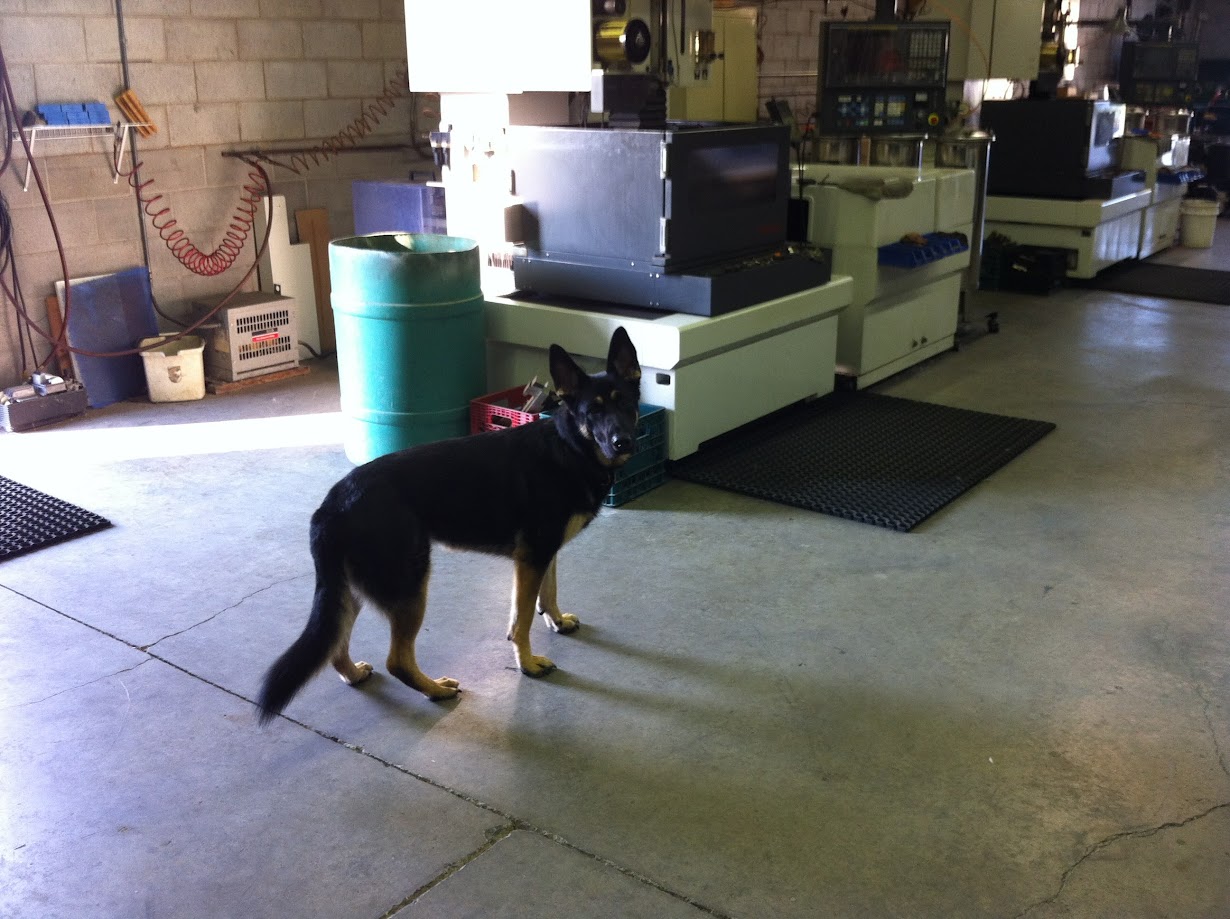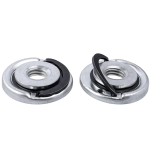Wire is cheating.......That looks like work. I'd rather press a button then go surf GTAM on my computer.

You are using an out of date browser. It may not display this or other websites correctly.
You should upgrade or use an alternative browser.
You should upgrade or use an alternative browser.
Steel cutting.
- Thread starter cycling
- Start date
Wire is cheating.......
But oh so accurate.
World's Most Expensive Seatpost Shim. +.0005 +/-.0001 slide fit to seatpost. I'm OCD about **** like that.
I have five because I can't be bothered changing disks. One for cutting concrete. one for grinding concrete, one for cutting steel, one for improving my welds and an inexpensive one from P.A. that is variable speed.What's the problem with a cheap 4.5" angle grinder? Almost an order of magnitude cheaper than the options you are considering.
The problem is a catch-22. To develop the accuracy skill you need to do a lot of cutting. If you're doing a lot of cutting an angle grinder is the wrong tool.
I agree 200% about taking time to do a rigid setup. Use straight edges clamped to the work piece as a guide.Prep with metal working is the key. Spending time planning and securing saves time in the long run.
Fast and sloppy ends up being slow and dangerous.
If you secure everything and have space to work in, you will gain confidence in your tools because you have control.
Holding the part and one hand and the tool in the other will always feel bad and lead to bloodshed.
Another thing that will up your game... rough out first and then finish. Scribe your lines and cut well away from them. Nibble away for finishing.
You will be amazed how good your stuff ends up looking and fitting.
Angle grinders have a lot of flaws. Torque is one especially if the handle is removed to get into a tight spot. Similarly the guard is often removed.
It takes longer to drive to the hospital than it takes to properly clamp a piece of steel.
In the end, the satisfaction of doing it right and treating yourself like a valuable asset far outweighs the time needed for a proper set up.
Your Guy at work got off lucky.For stuff like that, I just use and disc cutter with a zip disc. Easy and quick, but the cuts may not be the straightest.
All depends on how precise you need to be.
Just be careful with if. Guy at work wasn’t careful and the tool caught some loose clothing, clipped his gut and as he tried to turn it off it caught a glove and went and injured his whole palm.
I won’t get into details, but needless to say it’s a hospital visit and stitches…if you’re lucky.
Another guy on a site somewhere caught the strings of his hoodie in an angle grinder and the grinder spooled up into his neck and face. With peripheral speeds over 100 MPH there is no time to react. RIP.
I always cut the strings off.
One thing I find common with all angle grinder, cheap or brand name is the switched are clumsy, especially wearing gloves.
My most recent addition to the cutting department is a Milwaukee 18 volt steel cutting circular saw. I don't use it a lot but the ability to safely, quickly and accurately cut steel really opens horizons.
Mad Mike
Well-known member
I agreee you need more than one. I bought a good Milli cordless last year, it came with a quick change lock nut - game changer. I bought a few off amazon for my other grinders. The only problem is I had to retap them for 5/8"-11 arbor, cound only find M14 metricI have five because I can't be bothered changing disks. One for cutting concrete. one for grinding concrete, one for cutting steel, one for improving my welds and an inexpensive one from P.A. that is variable speed.
The problem is a catch-22. To develop the accuracy skill you need to do a lot of cutting. If you're doing a lot of cutting an angle grinder is the wrong tool.

One finger appears to have an impression from a recently removed ring. Good!View attachment 67826
Happy to help.
Edit... I got free coffee and donuts out of it as well. Thanks @cycling
In a tug of war between a 5 HP machine and a finger with a ring on it, the finger usually loses.
However I notice a wrist watch. Some sites have you relocate it to your belt.
Mad Mike
Well-known member
I've scraped a little skin here and there, but my scariest was using a wire wheel cup on a cordless grinder. I had a small bracket in a vice, the wheel caught the piece and pulled it from my hands. When the grinder hit the floor it was running, the damn thing bounced around my garage like an excited Tigger - I had to throw a tarp over the thing to catch it.Your Guy at work got off lucky.
Another guy on a site somewhere caught the strings of his hoodie in an angle grinder and the grinder spooled up into his neck and face. With peripheral speeds over 100 MPH there is no time to react. RIP.
I always cut the strings off.
One thing I find common with all angle grinder, cheap or brand name is the switched are clumsy, especially wearing gloves.
My most recent addition to the cutting department is a Milwaukee 18 volt steel cutting circular saw. I don't use it a lot but the ability to safely, quickly and accurately cut steel really opens horizons.
Mad Mike
Well-known member
Torque is the part that I find toughest to handle, particularly when cutting light gauge stuff. I have a couple of $29 CTC cheepies I use for that - the cheepies are torque-challenged -- makes them a lot more manageable for cutting sheet metal.I agree 200% about taking time to do a rigid setup. Use straight edges clamped to the work piece as a guide.
Angle grinders have a lot of flaws. Torque is one especially if the handle is removed to get into a tight spot. Similarly the guard is often removed.
It takes longer to drive to the hospital than it takes to properly clamp a piece of steel.
In the end, the satisfaction of doing it right and treating yourself like a valuable asset far outweighs the time needed for a proper set up.
I used to fix air tools and when a full sized angle grinder motor seized up the momentum of the stone would unthread itself from the spindle and send it scooting across the floor like an errant high speed bowling ball.I've scraped a little skin here and there, but my scariest was using a wire wheel cup on a cordless grinder. I had a small bracket in a vice, the wheel caught the piece and pulled it from my hands. When the grinder hit the floor it was running, the damn thing bounced around my garage like an excited Tigger - I had to throw a tarp over the thing to catch it.
Wire wheels and brushes. Wear a full face shield instead of or over safety glasses unless you like plucking bits of wire out of your cheeks and forehead.
This conversation got me thinking about various vise mounting systems. My garage is optimized to store the maximum possible number of motorcycles, so my workbench folds and is lag-bolted to the wall. Permanently mounting my vise to the workbench will put it at exactly shin height when the workbench is folded away, so F that idea. I already know how loud I'll scream the first time I smash my shin into that.
I think I'll probably bolt the vise to a plywood plate, with pins or bolts through the plate to match the dog holes on the workbench. Perhaps also angle iron or U-channel on two sides to catch the corner of the workbench securely. I've already been thinking of using the dog hole pattern as a plate template for other things, like my manual tire changer. I'd drill the same pattern into the deck of my open trailer to have a compatible mobile mounting surface.
I think I'll probably bolt the vise to a plywood plate, with pins or bolts through the plate to match the dog holes on the workbench. Perhaps also angle iron or U-channel on two sides to catch the corner of the workbench securely. I've already been thinking of using the dog hole pattern as a plate template for other things, like my manual tire changer. I'd drill the same pattern into the deck of my open trailer to have a compatible mobile mounting surface.
Mad Mike
Well-known member
Not just your face. I was cleaning some brickwork for reporting with a wire wheel, when I was done I dozens of wires imbedded in my arms and torso. You can't feel them go in, they shoot straight thru a tee shirt.I used to fix air tools and when a full sized angle grinder motor seized up the momentum of the stone would unthread itself from the spindle and send it scooting across the floor like an errant high speed bowling ball.
Wire wheels and brushes. Wear a full face shield instead of or over safety glasses unless you like plucking bits of wire out of your cheeks and forehead.
That changes once you get the needlenose pliers out to remove them.
Whenever I use a hacksaw on a big cut I remember my high school machine shop instructor's punishment for neglecting homework. You came in after class and he put a 2"X2" steel bar in a vise. He handed you a hacksaw with a dull blade and you made a square washer. If you broke the blade you started a fresh cut with another dull blade.
I only forgot once.
I only forgot once.
My go to is my chopsaw if I can use it, then a 4.5 inch angle grinder, then the sawzal... Circular saw will also find itself in the mix for longer cuts.
Using die grinder with a cutoff disk, I have had more than one blow apart and put chunks into what I assume is low earth orbit, luckily not into me. I will use them but for finer cuts.
I had a 6 inch angle grinder catch (kick back) once. Dumb me I grabbed it tighter and in the process pushed the trigger lock by mistake. The force ripped it out of my hand on the secondary handle. It then ran up my arm and across my chest... I looked like I lost a fight with a large dog.
On cutoff wheels, I also recommend not using the same ones on aluminum and steel. Bad things can happen with wheels blowing apart...
Using die grinder with a cutoff disk, I have had more than one blow apart and put chunks into what I assume is low earth orbit, luckily not into me. I will use them but for finer cuts.
I had a 6 inch angle grinder catch (kick back) once. Dumb me I grabbed it tighter and in the process pushed the trigger lock by mistake. The force ripped it out of my hand on the secondary handle. It then ran up my arm and across my chest... I looked like I lost a fight with a large dog.
On cutoff wheels, I also recommend not using the same ones on aluminum and steel. Bad things can happen with wheels blowing apart...


















